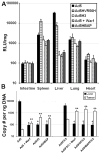Substitution of adenovirus serotype 3 hexon onto a serotype 5 oncolytic adenovirus reduces factor X binding, decreases liver tropism, and improves antitumor efficacy
- PMID: 20736345
- PMCID: PMC2945233
- DOI: 10.1158/1535-7163.MCT-10-0332
Substitution of adenovirus serotype 3 hexon onto a serotype 5 oncolytic adenovirus reduces factor X binding, decreases liver tropism, and improves antitumor efficacy
Abstract
Following intravascular delivery, an important route of administration for many clinical applications, the liver is the predominant site of adenovirus serotype 5 (Ad5) sequestration, thereby posing a risk of toxicity. In this regard, it has recently been shown that the Ad5 capsid binds to the blood coagulation factor X (FX) via the Ad5 hexon protein. This interaction mediates the majority of Ad5 liver transduction. Patient FX levels can be diminished by the administration of warfarin, a vitamin K inhibitor in the liver that decreases FX production; however, warfarin is a potent anticoagulant and can have a number of undesired side effects. Therefore, genetic modification of the virus to ablate FX binding is the preferred approach. Modifications of the hexon protein, specifically within the hypervariable 5 (HVR5) and 7 (HVR7) regions, have produced Ad5 vectors that show minimal liver sequestration. Our laboratory has pioneered adenovirus hexon modifications, including insertion of peptide ligands into the hypervariable regions and substitution of the adenovirus hexon with hexon proteins from alternate serotypes. Substitution of the adenovirus serotype 3 (Ad3) hexon protein onto the Ad5 capsid has been further characterized with regard to its interaction with FX and incorporated into an infectivity-enhanced conditionally replicative adenovirus (CRAd). In vitro evaluation of these hexon-modified vectors showed decreased binding to FX and decreased cell transduction via FX-mediated pathways. Furthermore, in vivo biodistribution studies in mice exhibited a decrease in liver sequestration. With the use of xenograft tumor models, the antitumor efficacy of the hexon-modified CRAds was enhanced over nonmodified controls.
Conflict of interest statement
Conflicts of interest: none
Figures





Similar articles
-
Identification of coagulation factor (F)X binding sites on the adenovirus serotype 5 hexon: effect of mutagenesis on FX interactions and gene transfer.Blood. 2009 Jul 30;114(5):965-71. doi: 10.1182/blood-2009-03-208835. Epub 2009 May 8. Blood. 2009. PMID: 19429866 Free PMC article.
-
Biodistribution and inflammatory profiles of novel penton and hexon double-mutant serotype 5 adenoviruses.J Control Release. 2012 Dec 28;164(3):394-402. doi: 10.1016/j.jconrel.2012.05.025. Epub 2012 May 22. J Control Release. 2012. PMID: 22626939 Free PMC article.
-
Adenovirus serotype 5 hexon mediates liver gene transfer.Cell. 2008 Feb 8;132(3):397-409. doi: 10.1016/j.cell.2008.01.016. Cell. 2008. PMID: 18267072
-
Tropism and transduction of oncolytic adenovirus 5 vectors in cancer therapy: Focus on fiber chimerism and mosaicism, hexon and pIX.Virus Res. 2018 Sep 15;257:40-51. doi: 10.1016/j.virusres.2018.08.012. Epub 2018 Aug 17. Virus Res. 2018. PMID: 30125593 Review.
-
The importance of coagulation factors binding to adenovirus: historical perspectives and implications for gene delivery.Expert Opin Drug Deliv. 2014 Nov;11(11):1795-813. doi: 10.1517/17425247.2014.938637. Epub 2014 Jul 18. Expert Opin Drug Deliv. 2014. PMID: 25036189 Review.
Cited by
-
Hexon modification to improve the activity of oncolytic adenovirus vectors against neoplastic and stromal cells in pancreatic cancer.PLoS One. 2015 Feb 18;10(2):e0117254. doi: 10.1371/journal.pone.0117254. eCollection 2015. PLoS One. 2015. PMID: 25692292 Free PMC article.
-
A recent perspective on fiber and hexon genes proteins analyses of fowl adenovirus toward virus infectivity-A review.Open Vet J. 2021 Oct-Dec;11(4):569-580. doi: 10.5455/OVJ.2021.v11.i4.6. Epub 2021 Oct 19. Open Vet J. 2021. PMID: 35070851 Free PMC article. Review.
-
Experimental virotherapy of chemoresistant pancreatic carcinoma using infectivity-enhanced fiber-mosaic oncolytic adenovirus.Cancer Gene Ther. 2014 Jul;21(7):264-74. doi: 10.1038/cgt.2014.26. Epub 2014 Jun 6. Cancer Gene Ther. 2014. PMID: 24903014 Free PMC article.
-
Glioma virus therapies between bench and bedside.Neuro Oncol. 2014 Mar;16(3):334-51. doi: 10.1093/neuonc/not310. Epub 2014 Jan 26. Neuro Oncol. 2014. PMID: 24470549 Free PMC article. Review.
-
Adenoviruses using the cancer marker EphA2 as a receptor in vitro and in vivo by genetic ligand insertion into different capsid scaffolds.PLoS One. 2014 Apr 23;9(4):e95723. doi: 10.1371/journal.pone.0095723. eCollection 2014. PLoS One. 2014. PMID: 24760010 Free PMC article.
References
-
- Edelstein ML, Abedi MR, Wixon J. Gene therapy clinical trials worldwide to 2007--an update. J Gene Med. 2007;9:833–42. - PubMed
-
- Imperiale MJ. Keeping adenovirus away from the liver. Cell Host Microbe. 2008;3:119–20. - PubMed
-
- Parker AL, Waddington SN, Nicol CG, et al. Multiple vitamin K-dependent coagulation zymogens promote adenovirus-mediated gene delivery to hepatocytes. Blood. 2006;108:2554–61. - PubMed
-
- Waddington SN, McVey JH, Bhella D, et al. Adenovirus serotype 5 hexon mediates liver gene transfer. Cell. 2008;132:397–409. - PubMed
Publication types
MeSH terms
Substances
Grants and funding
LinkOut - more resources
Full Text Sources
Other Literature Sources
Medical

